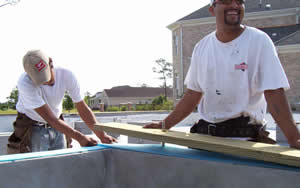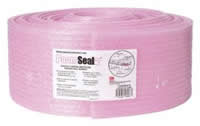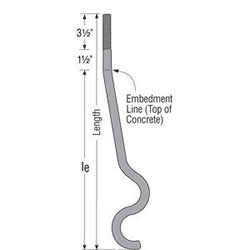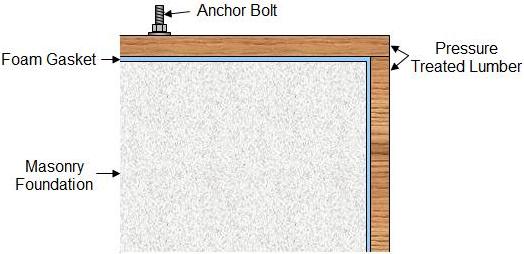
Figure 1 - Installing a sill plate
Note: The masonry foundation can be poured concrete or concrete blocks.
The sill plate should be pressure treated lumber. As a masonry foundation is porous it will draw moisture towards the piece of lumber that is used as a sill plate. Years ago a piece of tar paper was placed between the sill plate and the masonry foundation to protect the lumber from the moisture. Today, the use of pressure treated lumber eliminates the need for the tar paper.

Figure 2 - Sill plate gasket
The chemicals used in pressure treated lumber also provide protection against termites and other wood eating insect infestations.
Between the masonry foundation and the pressure treated lumber sill plate a foam gasket, as shown in Figure 2, or sealer as it is often called, is installed. The foam gasket prevents air leakage, either outside air entering the home or inside air exiting the home, by filling any voids between the top of the masonry foundation and the pressure treated sill plate. It is an important part of the sill plate installation.
The sill plate is attached to the masonry foundation using anchor bolts, as shown in Figure 3. The anchor bolt material should preferably be stainless steel. If you are using galvanized anchor bolts it must be approved for use with the new ACQ pressure treated lumber.
Note: The quantity, style and methods for installing the anchor bolts in the masonry foundation are subject to local building codes. Areas that are earthquake prone or that have high wind shear may require additional or non-standard techniques for their installation. Always consult your local building department or a structural engineer for design specifics.

Figure 3 - Masonry anchor bolts
Sill plates are used to make the transition from the masonry foundation to the wood structure. The sill plate is usually thought of as a horizontal piece of lumber. However, it is just as important that any vertical masonry surfaces also have a transition piece of pressure treated lumber installed in a similar manner as the sill plate, using a foam gasket between the masonry foundation and the lumber.
Figure 4 shows the installation of the sill plate, foam gasket and fastening for both horizontal and vertical surfaces.

Figure 4 - Sill plate installation
Note: It is not necessary to use horizontally installed anchor bolts to secure vertical transition pieces as the structural stresses are far less on a vertical transition piece of lumber and the horizontally installed sill plate. The use of stainless steel or ACQ pressure treated lumber approved concrete screws or fasteners are an acceptable installation method.
